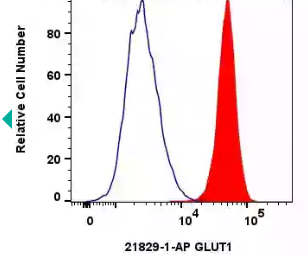

经过测试的应用
Positive WB detected in unboiled HT-29 cells, 37°C incubated mouse colon tissue
Positive IHC detected in rat brain tissue, human lung cancer tissue, human cervical cancer tissue, human breast cancer tissue
Note: suggested antigen retrieval with TE buffer pH 9.0; (*) Alternatively, antigen retrieval may be performed with citrate buffer pH 6.0
Positive IF-P detected in mouse brain tissue
Positive IF/ICC detected in HeLa cells
Positive FC (Intra) detected in HeLa cells
For optimal WB detection with 21829-1-AP, we recommend to avoid boiling the sample after lysis.
Planning an IHC experiment? We recommend our IHCeasy GLUT1 Ready-To-Use IHC Kit. GLUT1 primary antibody included.
Planning an IF experiment? We recommend our CoraLite® Plus 488 conjugated versions of this antibody.
推荐稀释比
APPLICATION DILUTION
Western Blot (WB) WB : 1:1000-1:8000
Immunohistochemistry (IHC) IHC : 1:2500-1:10000
Immunofluorescence (IF)-P IF-P : 1:1000-1:4000
Immunofluorescence (IF)/ICC IF/ICC : 1:200-1:800
Flow Cytometry (FC) (INTRA) FC (INTRA) : 0.40 ug per 10^6 cells in a 100 µl suspension
It is recommended that this reagent should be titrated in each testing system to obtain optimal results.
Sample-dependent, Check data in validation data gallery.
发表文章中的应用
KD/KO See 7 publications below
WB See 224 publications below
IHC See 45 publications below
IF See 40 publications below
FC See 1 publications below
ChIP See 1 publications below
产品信息
21829-1-AP targets GLUT1 in WB, IHC, IF/ICC, IF-P, FC (Intra), ChIP, ELISA applications and shows reactivity with human, mouse, rat samples.
Tested Applications WB, IHC, IF/ICC, IF-P, FC (Intra), ELISA Application Description
Cited Applications WB, IHC, IF, ChIP
Tested Reactivity Human, Mouse, Rat
Cited Reactivity Human, Mouse, Rat, Pig, Rabbit, Goat, Lasiopodomys Brandtii
Immunogen GLUT1 fusion protein Ag16282 种属同源性预测
Host / Isotype Rabbit / IgG
Class Polyclonal
Type Antibody
Full Name solute carrier family 2 (facilitated glucose transporter), member 1
Synonyms SLC2A1, SLC2A1,GLUT1, GLUT-1
Calculated Molecular Weight 492 aa, 54 kDa
Observed Molecular Weight 45-55 kDa
GenBank Accession Number BC121804
Gene Symbol GLUT1
Gene ID (NCBI) 6513
RRID AB_10837075
Conjugate Unconjugated
Form Liquid
Purification Method Antigen affinity purification
UNIPROT ID P11166
Storage Buffer PBS with 0.02% sodium azide and 50% glycerol pH 7.3.
Storage Conditions Store at -20°C. Stable for one year after shipment. Aliquoting is unnecessary for -20oC storage.
Glucose transporter 1 (GLUT1), also known as solute carrier family 2, facilitated glucose transporter member 1 (SLC2A1), is a uniporter protein responsible for the transport of glucose in many cell types and across the blood-brain barrier.
What is the molecular weight of GLUT1? Is GLUT1 post-translationally modified?
There are two forms of GLUT1 transporter that differ in their molecular weight. The 45-kDa form is found in glial cells, while the 55-kDa form is present in the endothelial cells regulating glucose transport over the blood-brain and blood-tissue barriers (PMID: 9630522). N-glycosylation of asparagine at position 42 is the only known post-translation modification of GLUT1 (PMID: 3839598).
What is the subcellular localization of GLUT1?
Glucose transporters, including GLUT1, are multiple-pass integral membrane proteins. GLUT1 is present at the plasma membrane but is also a subject of recycling between plasma membrane and endosomes.
What molecules can be transported by GLUT1?
The main substrate of GLUT1 transport is glucose, but it can also transport galactose, mannose, glucosamine, and reduced ascorbate.
What is the tissue expression pattern of GLUT1?
GLUT1 is expressed by many cell types but the highest levels are observed in erythrocytes and in the central nervous system (astrocytes). GLUT1 is responsible for glucose transfer across the blood-brain and blood-tissue barriers, including placental transport.
 扫一扫 关注我们
扫一扫 关注我们
